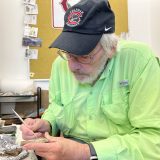The Foundations Of Science Communication A Grand Challenges Initiative team seeks to learn how scientists can best create dialogue with the public
May 2, 2018
As the Grand Challenges Initiative begins to close out its first year at Chapman University, a fuller picture of what its inaugural student class will be working on has formed. The next year of work will be spent developing out ideas, conducting more tests, and communicating their findings. For Freshman Monroe Roush, Ashley Nichols, and Daisy Haas, it’s that final step that they’ve been focused on studying: science communication. How do the public, both locally and in science communities elsewhere, trust and interact with research?
The group has been spending the final days of the school year tabling in the piazza, asking the community about how much they trust science, and what questions they have for those in the field. “What we’re hoping to do is evaluate how Chapman students interact with science, and how much they trust it,” says Roush. “Right now the main model of scientific communication is the Deficit model, which is where the scientific community assumes what the general public wants to know, and tells them about it. We’re trying to implement more of a two way dialogue where we’re asking what people want to know about, and that way we’ll be able to have more effective conversations about science.”
The plan, at least for now, is simply to gather data. Tabling sessions over the last semester, including two final ones on May 2 and May 3 in the Attallah Piazza, are meant to give the group some idea about the greater student body’s feelings towards science. Students can drop by and rate, on a scale from one to ten, how much they trust science, and chime in on what topics they’d like to know more about. This research will lead to events hosted in future semesters based around the feedback they’ve received, a way to impart science into the culture and have Schmid students and faculty interacting with the campus and communicating their knowledge.
“I think that just by starting conversations and making it more accessible we can close the gap between scientists and the public,” says Haas. “Better conversations can change the culture around science and the way that the general public views it, and hopefully make it more inclusive.”
“Chapman does a good job of helping students develop the skills for science communication, and we know that they’re unique in that way,” adds Roush. “But we know there are a lot of schools around the the country that aren’t as good at it. As scientists, we are not always very good at explaining our research, but there are some people out there who are doing really great work on that and we want to build on what they’re doing.”


